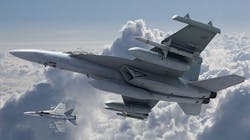Two companies to help Navy develop SWaP low-band radar jammers to clear the way for stealth aircraft
PATUXENT RIVER NAS, Md. – Two U.S. defense companies are helping the U.S. military in an urgent effort to develop low-band tactical RF jammers for low size, weight, and power consumption (SWaP) applications on the U.S. Navy EA-18G Growler electronic warfare (EW) carrier-based aircraft.
Officials of the Naval Air Systems Command at Patuxent River Naval Air Station, Md., are looking to L-3 Technologies Communications Systems-West in Salt Lake City, and the Northrop Grumman Corp. Mission Systems segment in Bethpage, N.Y., to investigate the use of existing technologies to develop a low-band tactical jammer for the EA-18G aircraft.
L-3 and Northrop Grumman are taking part in the Next Generation Jammer Low Band Increment 2 Demonstration of Existing Technologies (DET) project to increase the Navy's knowledge and understanding of existing technologies able to support an airborne wideband low radio frequency (RF) band jamming application where significant size, weight, power and cooling constraints exist, such as those on the EA-18G.
Low-band radar can be useful for detecting stealth aircraft like the U.S. F-35 joint strike fighter and B-2 bomber, and is needed urgently for the EA-18G, which virtually is the only dedicated electronic warfare aircraft in the U.S. inventory.
Related: Stealth killer? Russia's sixth-generation fighter might have a "radio-photonic radar"
The companies also will help the Navy use open-systems architectures -- particularly the ability to upgrade tactical jammer subsystems easily -- to enhance the long term system viability of a future low-band tactical jammer, and upgrade the system as necessary to keep pace with evolving threats.
Navy officials say they want to develop and field a SWaP-optimized low-band tactical airborne jammer as soon as feasibly possible. L-3 won a $35.8 million contract and Northrop Grumman won a $35.2 million contract. The Navy announced the two-year contracts last Thursday.
The contractors will help the Navy determine the milestone entry point for introducing low-band tactical jammer technologies to the Next-Generation Jammer, which is to replace the aging ALQ-99 tactical jammer on the EA-18G aircraft for airborne electronic attack.
The goal is to develop system-level alternatives for the best possible maritime electronic warfare capabilities, while making the most of existing and projected technologies.
Related: New frontiers in passive radar and sonar
Specifically, L-3 and Northrop Grumman will demonstrate a low-SWaP transmitter in a pod that will fit on Station 6 of the EA-18G; enhance the performance of frequency coverage, effective isotropic radiated power, spatial coverage, spectral purity, and polarization; obtain existing contractor data related to transmitter group performance; and assess the potential to deploy an open-systems interim pod solution rapidly.
The Navy will demonstrate these technologies on station 6 of the F/A-18E used as a surrogate for the EA-18G aircraft at Patuxent River NAS for antenna and radar cross section measurement.
On these contracts, L-3 will do the work Salt Lake City; Boulder, Colo.; Carlsbad, Calif.; Stuart, Fla.; Waco, Texas); Reston, Va.; Guthrie, Okla.; Stow, Mass.; St. Louis; and in Europe. Northrop Grumman will do its work in Linthicum and Hollywood, Md.; Bethpage, North Amityville, and Melville, N.Y.; Rolling Meadows, Ill.; Melbourne, Fla.; and Redondo Beach, Calif. Both contractors will be finished by June 2020.
For more information contact L-3 Communications Systems-West online at www2.l3t.com/csw, Northrop Grumman Mission Systems at www.northropgrumman.com, or Naval Air Systems Command at www.navair.navy.mil.
Ready to make a purchase? Search the Military & Aerospace Electronics Buyer's Guide for companies, new products, press releases, and videos

